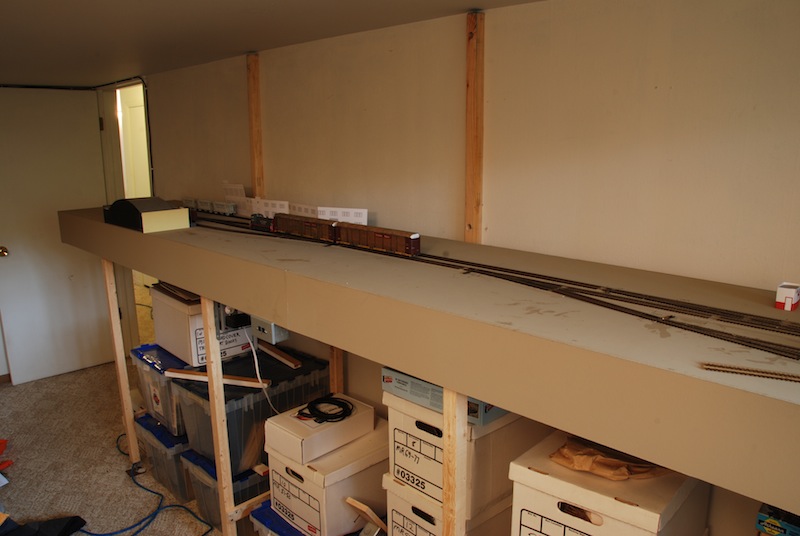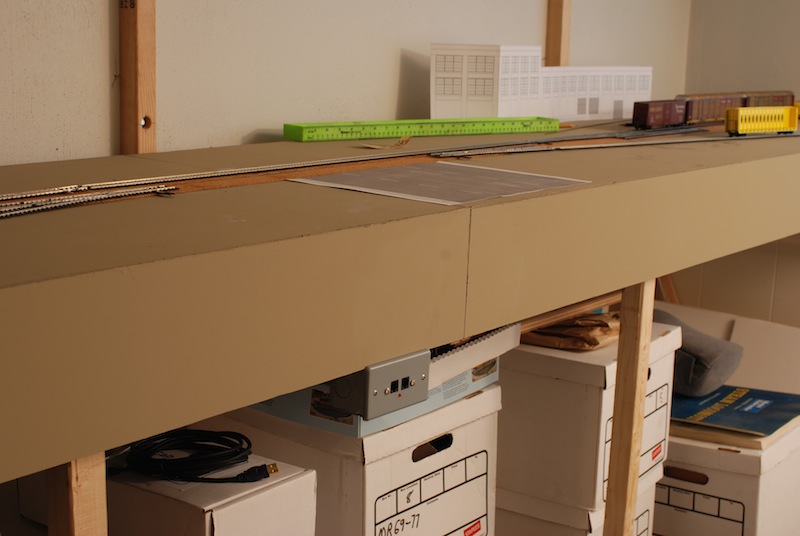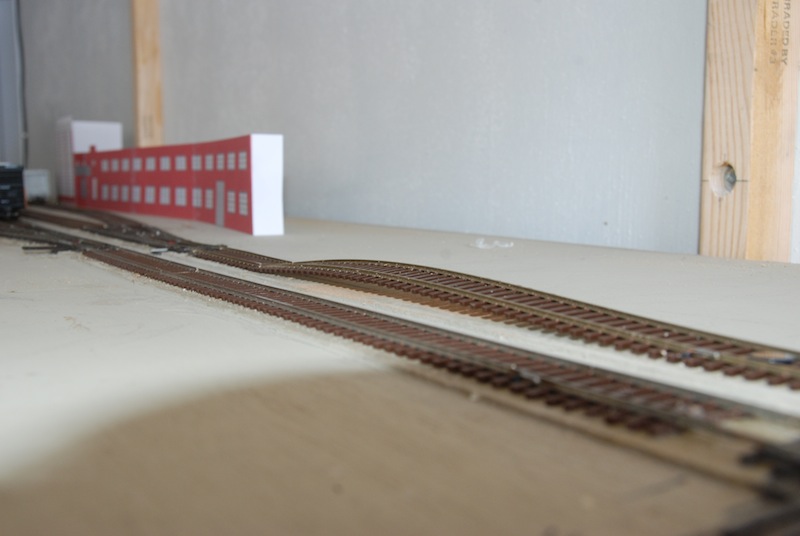Posts: 73
Threads: 5
Joined: Jul 2010
Hello,
The Burbank Branch had a mishap from unseasonably warm weather (heater up too high) and a section of track buckled up from the roadbed. Trains are being diverted.
The track was adhered to the cork roadbed by acrylic caulk. To put the track back down I have to remove the old caulking from the roadbed so the new caulking will adhere. (fresh acrylic will not stick to dried acrylic) Any suggestions on how to remove the dried caulking and save the cork roadbed? I was going to sand it down but was wondering if anyone had any tricks.
Thanks,
John
John
Posts: 3,683
Threads: 118
Joined: Jan 2009
How much do you have to redo? Seems it would be easiest just to replace the cork roadbed in that section.
Can you give us more info on what occurred to serve as a warning for the rest of us? How high was the heater set? How did the track buckle? Had you left gaps at the rail joints every so often?
Can you post some photos of the damage?
Posts: 73
Threads: 5
Joined: Jul 2010
It is one section of flex track. I did leave gaps but they must not have been big enough. It was around 65 degrees when the track was put down, but I'm guessing the room got up to 78 (temps in fahrenheit) or so when they buckled. The room the layout is in, tends to be the warmest room in the house and gets hotter when trying to heat the rest of the house in the winter. I will be leaving a bit more of a gap in the rails this time around.
John
Posts: 2,540
Threads: 63
Joined: Dec 2008
I just did a little calculation. For simplicity, I assume 50" of track and that the middle bit rises 1".
So it looks like 2 right angle triangles, sides 25" and 1" and a hypotenuse of (using my old drinking buddy Pythagoras's theorem) 25.02". OK, Now, there may be a little variance because everything will really be curved, but that's a mighty small piece expansion. (looks like 0.08%)
I had it happen on my layout. I have a bridge over the fireplace and the electric heater in there was cranked up and my track rose up because it wasn't held down.
Digression: This is an old school problem. The emperor decreed that a belt was to be placed around the earth at the equator. The equator is exactly 25000 miles around (to make the math easier) and round. The team assigned this duty slipped up and made the belt one mile too long but they said "We'll just spread out difference evenly and no one will notice."
So did anyone notice? How much of a gap was there?
David
Moderato ma non troppo
Perth & Exeter Railway Company
Esquesing & Chinguacousy Radial Railway
In model railroading, there are between six and two hundred ways of performing a given task.
Most modellers can get two of them to work.
Posts: 3,021
Threads: 160
Joined: Dec 2008
Also keep in mind that the expansion/contraction of wood because of humidity changes can cause buckling - and may be more significant than rails expanding or contracting.
--
Kevin
Check out my Shapeways creations!
3-d printed items in HO/HOn3 and more!
<!-- m --><a class="postlink" href="https://www.shapeways.com/shops/kevin-s-model-train-detail-parts">https://www.shapeways.com/shops/kevin-s ... tail-parts</a><!-- m -->
Posts: 3,683
Threads: 118
Joined: Jan 2009
nachoman Wrote:Also keep in mind that the expansion/contraction of wood because of humidity changes can cause buckling - and may be more significant than rails expanding or contracting.
Kevin, that is what I am thinking.
Posts: 3,683
Threads: 118
Joined: Jan 2009
I looked up the expansion rate of metals. Nickel silver wasn't listed, but the nickel silver track we use is actually a type of stainless steel, there isn't any silver in it at all. All of the stainless steels, and all of the nickel alloy metals had an expansion rate near .000008 inch per inch of material per dereee F of temp rise.
So, if we had 36 inches of track at a normal room temp, say 68 degrees, and the temp had risen 10 degrees, we would calculate .000008 x 36 x 10 and we would arrive at .00288 inches, round to .003 inch. That's 3 thousandths of an inch. If any rail gaps at all were left every so often, I don't see that this would be enough to cause buckling of the track. It is much more likely that the wood shrank as the moisture content went down, and this is what caused the buckling.
So my question about the rail gaps was off base. Rail gaps wouldn't protect against the benchwork wood shrinking. I'm thinking that using ripped plywood instead of dimensional lumber is a good idea.
Posts: 1,817
Threads: 27
Joined: Dec 2009
Gary S Wrote:... It is much more likely that the wood shrank as the moisture content went down, and this is what caused the buckling. ...
... Rail gaps wouldn't protect against the benchwork wood shrinking. I'm thinking that using ripped plywood instead of dimensional lumber is a good idea.
I've used dimensional lumber for 35+ years. I have never had a problem with "buckling" of any sort. I have built layouts in the Northeast, the South, the West Coast and now in Sub-Tropical Florida. I have had to deal with buying lumber in the dead of a snowy winter day and taking it down to the warm basement. I have bought lumber in 85% humidity and taken it inside to 45% humidity. No buckling
But ... many years ago, when I was a teenager, I read some advice about building benchwork ... it may have even been in Linn Westcott's " How to Build Benchwork" book ...
Bring the lumber into the space where the benchwork is to be built ... and then resist the temptation to build for a week! Allow the lumber to adjust to the conditions in the room or the basement, or wherever you are going to build your railroad. I have followed that advice. I still use dimensional lumber ... and I use plywood for sub-roadbed and homosote for roadbed and I have never had a problem with buckling.
biL
Lehigh Susquehanna & Western
"America will never be destroyed from the outside. If we falter and lose our freedoms, it will be because we destroyed ourselves." ~~Abraham Lincoln
Posts: 3,683
Threads: 118
Joined: Jan 2009
biL, I've heard plenty of stories of buckling track. I've never seen it first hand though. Still, all the horror stories must have some ring of thruth to them.
When my layout was in the non-climate-controlled layout was in the garage, it experienced lows in the upper 20s F and highs in the low 100s F. Humidity would have varied from high 90 percent to around 50 percent. Never had a single issue. I did leave small gaps (an exacto knife blade width) between every other length of flex track, the benchwork was 3/4" exterior plywood ripped into 1 bys, 1/4 luan plywood on that, and then had the 2" foam on that.
I'm happy to hear that your previous benchwork had no issues. I wonder what the difference was between yours and those that experienced problems.
Posts: 3,021
Threads: 160
Joined: Dec 2008
Two thoughts: I've learned about swelling lumber from none other than Norm Abram  He claims it swells more perpendicular to the grain than parallel to the grain. Good woodworkers know this, and know how to make cabinets and furniture that does not fail or warp. And - nickel silver is actually a type of brass - not steel - no iron.
--
Kevin
Check out my Shapeways creations!
3-d printed items in HO/HOn3 and more!
<!-- m --><a class="postlink" href="https://www.shapeways.com/shops/kevin-s-model-train-detail-parts">https://www.shapeways.com/shops/kevin-s ... tail-parts</a><!-- m -->
Posts: 3,683
Threads: 118
Joined: Jan 2009
You're right, Kevin. I just googled it and it is made from copper, nickel, and zinc. Brass is copper and zinc, so the nickel silver is brass with the nickel added. Don't know why I was thinking it was stainless steel. It should have dawned on me that the track is much softer than stainless steel.
So, the expansion rate would be somewhat greater than my previous calculation.
Posts: 10,786
Threads: 248
Joined: Dec 2008
John, I'm curious to know if you have that section ballasted.
I believe that by ballasting and gluing the ballast that we in fact make the rail expand vertically, the same results the prototype gets with rail anchors. I solder all my joints, and have for 40 years, and I have never had a problem with expansion or contraction of the rail.
Charlie
Posts: 73
Threads: 5
Joined: Jul 2010
Great info guys!
Here is more stuff I left out. The benchwork is all cut from 3/4" birch plywood. The wood sat in the basement (layout location) precut for over 6 months before being assembled. The sides of the benchwork are 4.5" deep, with a laminate of masonite for the facia 6" deep. After building the benchwork all wood was painted including the underside to seal it. The track was not ballasted yet. The rails were left unsoldered from adjoining rails because I wanted gaps to control the rail expansion. The specific affected track length is 26". The track was straight, no curve. The track sits on gasket cork that was painted prior to laying the track to seal it.
The benchwork is actually made up of two free-mo modules 24"x7.5' each. The buckle did occur at the spot where the two modules join. The track at this point is a butt fit to the edge of each module, with a slight gap for expansion (the width of a dremel cutoff wheel). There is a parallel track 2" away that crosses the same modules that is unaffected.The modules are connected with 3 through bolts, which are still tight.
From previous discussion, this sounds like it would be the benchwork rather than the rail. My question is wouldn't the paint have sealed the wood enough to curtail the affects of heat and humidity?


John
Posts: 3,683
Threads: 118
Joined: Jan 2009
With the way your benchwork is built, I am shocked that you had the issue. You did a first class job on the construction, and plywood typically doesn't expand and contract very much. The paint should have helped maintain the moisture content of the wood. The only variable I see is that you mentioned "gasket" cork. How thick is it, and what are its characteristics? Could it have dried out in the high heat and shrunk a bit?
I sure wish you would have taken some photos of the buckled track. We always hear of these things, but never get to see it (unless it happens to us! :cry: )
Posts: 73
Threads: 5
Joined: Jul 2010
Thanks, Gary, I thought I was doing all the recommended steps.
The cork is small engine gasket material, 1/16", purchased at True Value. It was glued down to the painted plywood with acrylic caulking, and then painted before the track was glued down to the cork.
And with a little help from a thumb tack I have recreated the disaster for posterity and your warped (pun intended) viewing pleasure.


John
|



 He claims it swells more perpendicular to the grain than parallel to the grain. Good woodworkers know this, and know how to make cabinets and furniture that does not fail or warp. And - nickel silver is actually a type of brass - not steel - no iron.
He claims it swells more perpendicular to the grain than parallel to the grain. Good woodworkers know this, and know how to make cabinets and furniture that does not fail or warp. And - nickel silver is actually a type of brass - not steel - no iron.